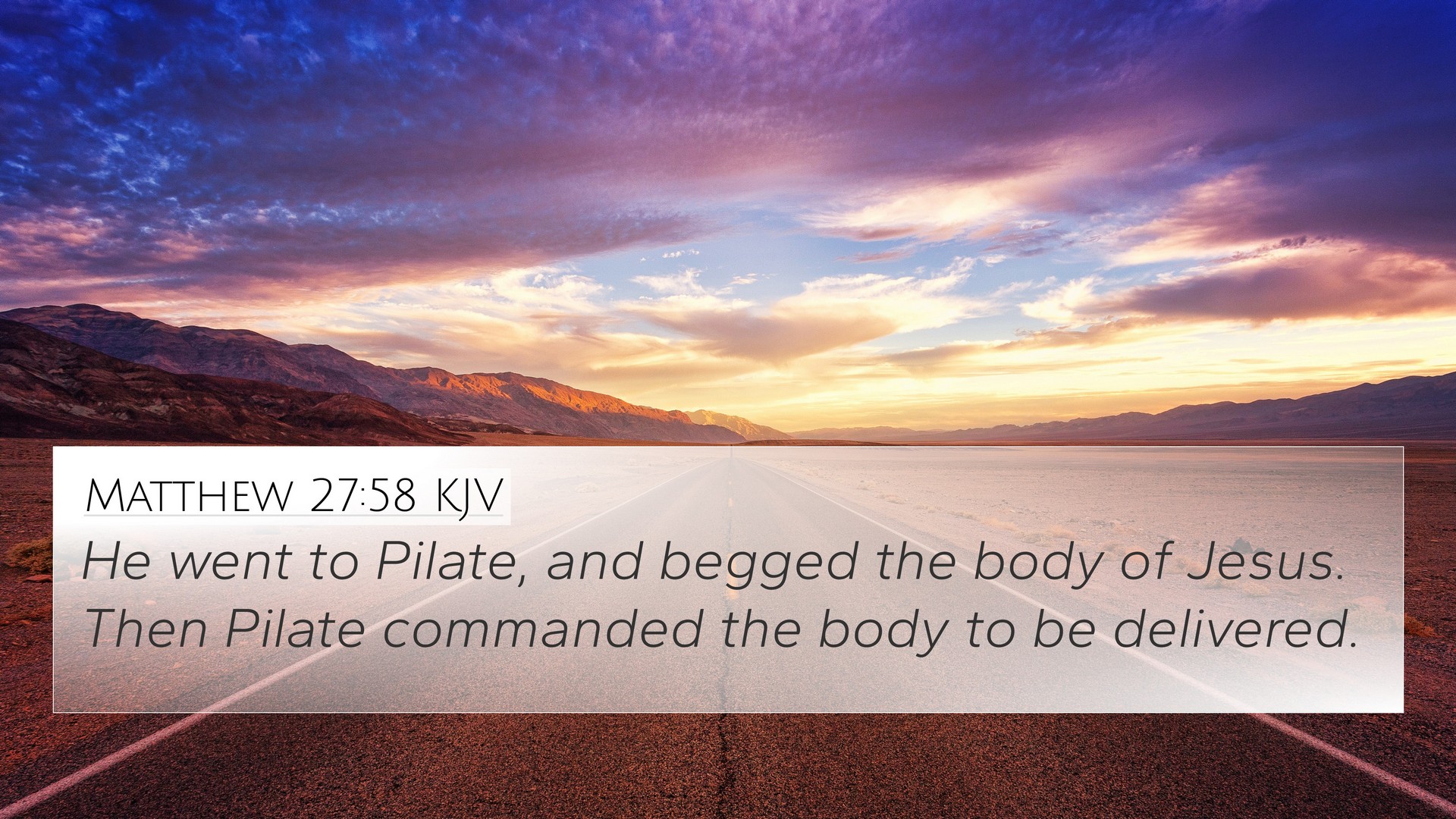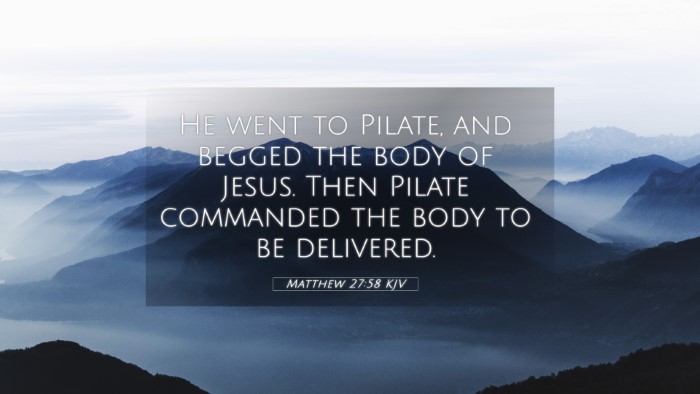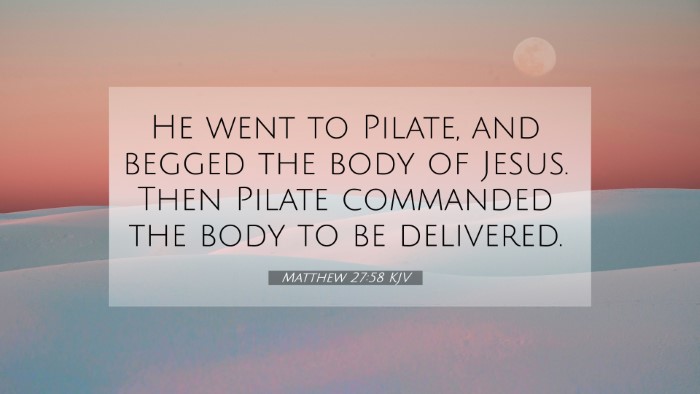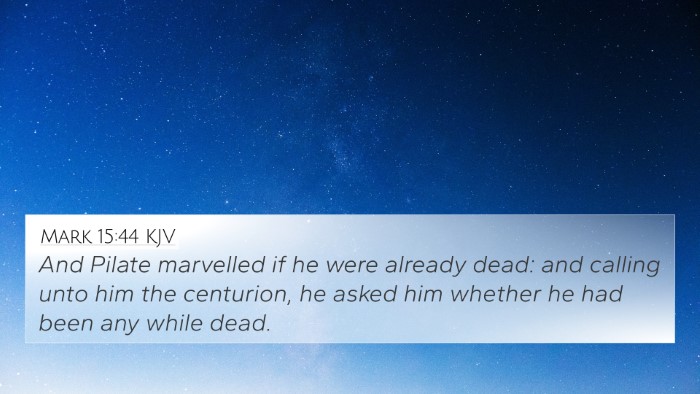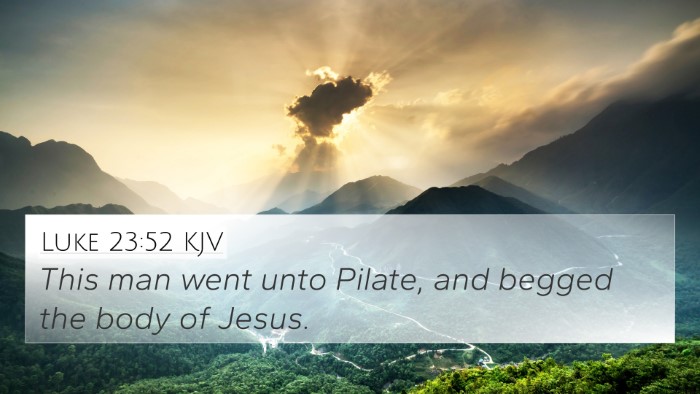Understanding Matthew 27:58
Bible Verse: Matthew 27:58 - "He went to Pilate and asked for the body of Jesus. Then Pilate ordered it to be given to him."
This verse encapsulates a significant moment in the crucifixion narrative, emphasizing the actions of Joseph of Arimathea as he seeks the body of Jesus after His death. The verse raises themes of courage, devotion, and the fulfillment of prophecies regarding the Messiah's burial.
Interpretation and Analysis
The request made by Joseph is extraordinary in several contexts, combining insights from various public domain commentaries.
- Matthew Henry: Joseph's actions are portrayed as courageous and defiant against the fear of the Jewish authorities. His request signifies a deep respect for Jesus, emphasizing the idea that even in death, Jesus was honored.
- Albert Barnes: Barnes points out that this act underscores Joseph's faith, hinting at the transformation he underwent by openly associating with Jesus, regardless of the potential societal repercussions.
- Adam Clarke: Clarke further elaborates that Joseph’s initiative in securing the body reflects his understanding of the prophecies concerning Jesus, notably Isaiah 53:9, which foretold a rich man's burial.
Thematic Connections
Matthew 27:58 connects with various biblical themes and scriptures that embody similar sentiments of intervention, sacrifice, and fulfillment of prophecy:
- Isaiah 53:9: "And they made his grave with the wicked, and with the rich in his death." - This Old Testament prophecy foreshadows Joseph's significant role in Jesus' burial.
- John 19:38-40: This parallel passage elaborates on Joseph of Arimathea requesting the body, further solidifying the Gospels' cohesive narrative about deposition and burial.
- Mark 15:43: "Joseph of Arimathea, a prominent member of the Council, who was himself waiting for the kingdom of God, went boldly to Pilate and asked for Jesus' body." - Highlighting Joseph's boldness.
- Luke 23:50-53: This account deepens the understanding of Joseph's character and his alignment with godly aspirations in a challenging environment.
- 1 Corinthians 15:4: "That he was buried, and that he rose again the third day according to the scriptures." - Affirming the necessity of His burial in the Gospel narrative.
- Matthew 28:1-6: Connects the burial to the resurrection, indicating the victory over death and linking it to the overarching theme of redemption.
- John 3:16: Relates to the broader themes of divine love and sacrifice, contributing to the discussion of Jesus' mission and its implications.
- Philippians 2:8: Echoes the humility of Christ's sacrifice, drawing a connection to His burial and subsequent resurrection.
- Romans 6:4: “We were therefore buried with him through baptism into death...” - This shows how the burial is integral to Christian doctrine.
- Acts 13:29: “When they had carried out all that was written about him, they took him down from the tree and laid him in a tomb.” - Reflection on the completion of Jesus' earthly mission and His burial.
Reflections on Joseph's Role
Joseph of Arimathea's character showcases the importance of faith in action. His willingness to approach Pilate — a risky endeavor given the political and religious tension — serves as a reminder of how personal conviction can lead to significant outcomes. His courage exemplifies how individuals can stand up for their beliefs, even amidst fear and controversy, qualifying him as a model for modern believers.
Conclusion
Matthew 27:58 speaks not only to the burial of Jesus but also to the substantial implications of faith and action in the lives of believers. It stands as a testament to how often biblical texts interconnect to convey deeper truths about God's plan for humanity. Through careful analysis and connections between Bible verses, we see that Joseph's role is pivotal in the story of Jesus’ death, ensuring that the prophecy is realized and that the narrative continues through both his act of physical care and ultimate recognition of Christ's glory.
Exploring Bible Verse Connections
Understanding Matthew 27:58 within its broader biblical context assists believers in recognizing the connective tissue throughout scripture. The various themes—sacrifice, honor, and fulfillment of prophecy—can be explored through dedicated study using tools for Bible cross-referencing. To deepen one's understanding, employing resources such as a bible concordance or a bible cross-reference guide can facilitate exploration of significant themes within the scriptures.
Recommended Practices
- Utilize a cross-reference system to uncover deeper insights into connected themes.
- Engage in cross-referencing Bible study methods for a more structured exploration of interrelated verses.
- Leverage Bible reference resources to broaden understanding of core biblical narratives.
- Consider the comparative study of Pauline epistles to draw parallels with the Gospel narratives.
This exploration invites deeper engagement with the Scripture, enriching the spiritual journey through a well-rounded understanding of biblical truths and encouraging further investigation into connections between Bible verses.
